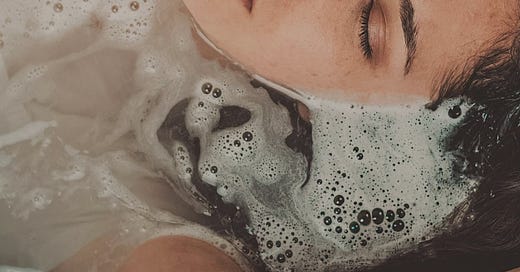✍🏽 Staying Present: Moving Beyond Good/Bad to the Heart of the Story
"The postpartum period is electric with powerful stories and images for us to explore, and myths and realities for us to unknot."
I’m not sure at what age I decided I was a “bad” artist, but at some point growing up I came to the conclusion that I could not draw. As an adult, I would say this as a disclaimer before I showed anyone a drawing.
This identity as a “bad artist” did not stop me from drawing. Instead, it buried the practice. I pushed drawing to the edges of my life and placed primacy on writing, something I deemed myself “good” at. My doodles found a home in the margins of my notebooks. I obsessively drew daisy-like flowers all over my journals or a series of parallel lines. I colored in parts of my letters: o’s, the little ovals in lowercase e’s, the circles of g’s and d’s.
Not until I was 34 and eight months pregnant with my second son who was diagnosed in utero with a rare musculo-skeltal condition did I open myself to the power of drawing as a means of thinking and storytelling and discovery.
I had just begun maternity leave and was leafing through Pam England’s book Birthing From Within, reading her chapters on birth art when I decided I would try it. I had notebook paper, my favorite writing pen (a pilot G-2), and a series of suggested exercises. Why not? I thought. It might be fun, and if there is anything a high-risk pregnancy needs, it’s fun.
Making the birth art was revelatory. My artwork became a doorway to access feelings, experiences, fears, complicated emotions, grief, and buried hopes about my pregnancy and my son that for half the pregnancy I had repressed. It was the first time, probably since I was in elementary school, that I was open and receptive to what drawing could uncover. I wrote about the experience in an essay called “Pregnancy, Art, and Censorship.”
Years later, a workshop teacher recommended the work of Lynda Barry, and I began using her drawing and writing techniques in my creativity practice and journaling, eventually bringing them into my workshops.
“My artwork became a doorway to access feelings, experiences, fears, complicated emotions, grief, and buried hopes about my pregnancy and my son that for half the pregnancy I had repressed.”
According to Barry, “Drawing is a way of thinking.” It’s not about whether it is good, bad, beautiful, terrible, or any other adjective describing its quality.
I was trapped in ideas of good/bad, and the habit of using “bad” to describe my drawings closed me off to something more important. It prevented me from seeing what the drawing gave me access to— ideas, images, and emotions that my unconscious was trying to bring to light. Barry calls these things that bubble up from our creativity practice Images or the Image World (try not to get hung up on the idea of image, it’s more of a feeling, a knowing).
When I focused on judging my drawing what I didn’t realize was that I was blocking myself from one of the most instinctive ways for humans to think. Drawing has been part of our evolution. The fact that cave paintings exist on every continent except Antarctica is one proof of this, but so too is the natural way children draw, or maybe you’ve suddenly picked up a stick and drawn in the sand one day at the beach.
Finally letting go of judging my drawing skills allowed me to open up to the thinking it revealed. I was so fixated on judging and qualifying, deciding if it was good or bad and this closed-mindedness had caused me to write-off a powerful way of thinking for decades.
I designed “Afterbirth: Writing Postpartum Narratives” from the inspiration of Lynda Barry whose work places us in the nexus of writing, drawing, and the combination of the two in comic making. That’s three modes of storytelling, three means of sieving our unconscious mind, three ways of thinking to access our unconscious Image World.
I also designed this workshop to honor the birth artwork I made reading Pam England’s book. The postpartum period is electric with powerful stories and images for us to explore, and myths and realities for us to unknot. It is a rite of passage interwoven with grief and growth, deep love and profound loss. It is my hope that by exploring our complex postpartum journeys in a supportive group, by using visual and written storytelling techniques, we will discover the stories we are called to tell.
ABOUT THE INSTRUCTOR
Sarah Dalton (she/her) is a Latina writer, editor, and teacher. She is an alumna of VONA and Macondo, AWP’s Writer to Writer Mentorship, and the MFA program at San José State. Her nonfiction has appeared in Crab Creek Review, [pank], MUTHA Magazine, Reed, River Teeth’s “Beautiful Things.” Originally from the San Francisco East Bay, she’s finding roots in the Pacific Northwest.
Whether you're here for the first time or a regular reader, thank you for being part of our community. If you're ready to deepen your engagement, our paid subscription offers a richer experience with exclusive content and community features. Found value today? Share the love with a ❤️.
Browse our Bookshop.org collection for more literary discoveries.





